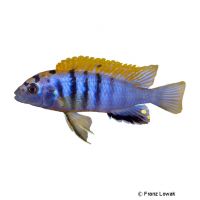Kimpuma (Labidochromis sp. 'Hongi')
| Kimpuma Labidochromis sp. 'Hongi' | |
|---|---|
| Name | Kimpuma |
| Name Lat. | Labidochromis sp. 'Hongi' |
| Family | Cichlids |
| Family lat. | Cichlidae |
| Order | Cichlids |
| Order lat. | Cichliformes |
| Origin | Lake Malawi |
| Habitat | Rocky shore |
| Diet | Omnivore, aufwuchs |
| pH | 7.5-8.8 |
| Behavior | Semi-aggressive |
| Keeping | Harem |
| Care Level | Moderate |
| Reproduction | Mouthbrooder |
| Breeding | Simple |
| Life Span | 6-10 years |
| Protection | No |
| Metric Units | |
| Size | 8-9 cm |
| Temperature | 24-28 °C |
| Hardness | 10-25 °dH |
| Aquarium | ~ 300 l |
| US Units | |
| Size | 3"-3.5" |
| Temperature | 75-82 °F |
| Hardness | 178-445 ppm |
| Aquarium | ~ 80 gal |
Distribution and habitat
The distribution area of the Hongi Malawi Cichlids is exclusively (endemic) Lake Malawi, where they are found on the east coast near the islands of Hongi and Lundo (Tanzania) and have produced several site variants. They belong to the group of mbuna, which lives in the rocky shore zones.
Maintenance
The aquarium setup should have rock structures reaching to the water surface, with many crevices, caves and shelters that serve as hiding places, as well as robust plants and some free sand areas. There should be no detectable ammonia, ammonium or nitrite, and the nitrate level should not exceed 100 mg/l. To ensure the water quality and oxygen content, a filter and heater adapted to the aquarium size is required, as well as lighting for the species-appropriate day-night rhythm of the animals.
Diet
They feed mainly on the microorganisms found in the plant cover (growth) as well as insects and insect larvae. The food supply consists of live, frozen and dry food. For a balanced diet, feed once a day with a high-quality dry food for Malawi cichlids (flakes, granules, pellets) as well as cyclops, daphnia, artemia and mosquito larvae (live or frozen). In addition, they also need some vegetable food, such as algae leaves and commercial green food (kelp, spirulina)
Only feed as much as will be eaten within a few minutes. A regular and varied diet promotes health and increases resistance.
Behaviour and compatibility
They are a mostly peaceful, less territorial mbuna species, both intraspecies and towards other fish. They should be kept in a harem, one male with several females. Keeping multiple harems is only recommended in a larger and richly structured tank. They can be socialized well with other cichlids from Lake Malawi
Basically, only compatible fish species with similar demands on water condition and water temperature should be socialized.
Sex dimorphism
The male is larger and usually more intensely colored at spawning time. It has several distinct yellow egg spots on the anal fin, which are weaker or absent in the female.
Reproduction and breeding
They are maternal mouth brooders. Immediately after spawning on a rock, the females take the eggs, 5-30 of them, into their throat sac for mouthbrooding. They keep the fry in their throat sac even after hatching. After about 3 weeks, the fry are released and brood care ends. During the entire brood care, the female does not take any food.
Fry must be fed several times a day with special rearing food (Artemia nauplii). In community tanks breeding is hardly possible, because the fry are easy prey.
Important
Different site varieties of Hongi Malawi cichlids should not be kept together, but neither should they be socialized with other Labidochromis sp. as they can interbreed (hybridize)
Red mosquito larvae should not be fed, as they can damage the digestive tract.
The well-being of the fish should be checked regularly. Temperature should be checked daily, pH, hardness and nitrate levels at least every 14 days. Regular partial water changes are recommended, even if the contaminant level has not yet reached the upper limit. Sudden changes in water quality should be avoided. Newly introduced fish must be accustomed slowly to the water in the aquarium.
Further literature can be found in your pet store.
References
Text: Werner Winter; Image: Franz Lowak
Source: BMELV (1998): Tierschutzgutachten - Haltung von Zierfischen (Süßwasser); BAENSCH & RIEHL(2004): Aquarien Atlas Bd. 5, Mergus Verlag; ENGELMANN (2005): Zootierhaltung - Tiere in menschlicher Obhut: Fische, Verlag Harri Deutsch
- Gemäß § 21 Abs. 5 Tierschutzgesetz idgF
